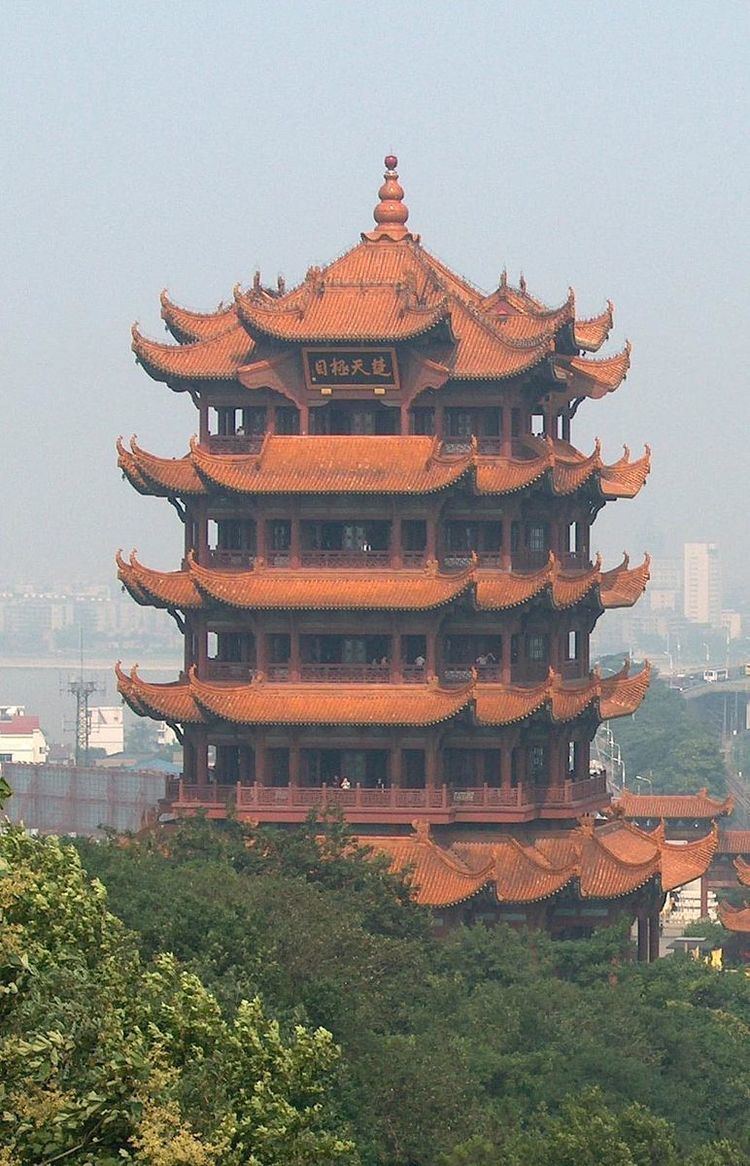Simplified Chinese 黄鹤楼 Hanyu Pinyin Yale Romanization Wòhng hohk làuh Opened 1985 Phone +86 27 8884 8188 | Traditional Chinese 黃鶴樓 IPA [xwǎŋ xɤ̂ lǒu] Jyutping Wong4 hok6 lau4 Province Hubei Architect Sun Quan | |
 | ||
Address Huanghelou E Rd, Wuchang Qu, Wuhan Shi, Hubei Sheng, China, 430000 Similar East Lake, Wuhan Yangtze River Brid, Yueyang Tower, Pavilion of Prince Teng, Guiyuan Temple | ||
Yellow crane tower wuhan hubei
Yellow Crane Tower (Chinese: 黄鹤楼; pinyin: Huáng hè lóu) is a traditional Chinese tower located in Wuhan, in central China. The current structure was built in 1981, but the tower has existed in various forms since at least AD 223. The current Yellow Crane Tower is situated on Sheshan (Snake Hill), one kilometer away from the original site. It is on the bank of the Yangtze River in Wuchang District, Wuhan, in the Hubei province of central China.
Contents
- Yellow crane tower wuhan hubei
- Yellow crane tower
- History
- Legends
- Poem by Cui Hao
- Poem by Li Bai
- Modern Association With Poetry
- Tourism
- References
Yellow crane tower
History
The original site of the tower was on the Yellow Crane Jetty, a location situated west of Xiakou. The Yuanhe Maps and Records of Prefectures and Counties notes that after Sun Quan, founder of the kingdom of Eastern Wu, built the fort of Xiakou, a tower was constructed at this location and named after the Yellow Crane Jetty.
The tower has been destroyed twelve times, both by warfare and by fire. In the Ming and Qing dynasties alone, the tower was destroyed and rebuilt twelve times and was repaired on ten separate occasions. The last tower at the original site was built in 1868 and destroyed in 1884. In 1957, the Wuhan Yangtze River Bridge was built with one trestle of the bridge on the Yellow Crane Tower's site. In 1981, the Wuhan City Government rebuilt the tower at a new location, about 1 km (0.62 mi) from the original site. The current tower was completed in 1985.
Legends
There are at least two legends related to the Yellow Crane Tower. In the first, an Immortal (仙人) named Wang Zi'an (王子安) rode away from Snake Mountain on a yellow crane and a tower was later built in commemoration of this story. In the second legend, Fei Wenyi (费文祎) becomes immortal and rides a yellow crane, often stopping on Snake Hill to take a rest.
The tower is also a sacred site of Daoism. Lü Dongbin is said to ascend to heaven from here.
Poem by Cui Hao
Yellow Crane Tower was made famous by an 8th-century poem written by Cui Hao, titled "Yellow Crane Tower" (黄鹤楼). The original text of the poem is shown below:
A modern English translation is:
Poem by Li Bai
There are other famous poems about the Yellow Crane Tower by Li Bai. One was written on the occasion of Bai parting with his friend and poetic colleague, Meng Haoran. The poem is titled "Seeing off Meng Haoran for Guangling at Yellow Crane Tower" (黄鹤楼送孟浩然之广陵), and is shown in its original form below:
A modern English translation is:
Modern Association With Poetry
As of 1988, one of the top floors in the Yellow Crane Tower is reserved for visiting poets of note, and the general public is only allowed to view it from the outside. This floor is fully equipped with desks, chairs, papers, brushes and inks.
Tourism
The top of the tower has a broad view of its surroundings and the Yangtze River. Yellow Crane Tower is considered one of the Four Great Towers of China. In its modern version, it has the appearance of an ancient tower but is built of modern materials, including an elevator. Each level has its own display. To the east on the hill, a large temple bell may be rung by tourists for a small fee. There are court dances in the western yard during the week-long celebration of China's National Day (October 1). The tower is classified as an AAAAA scenic area by the China National Tourism Administration.
